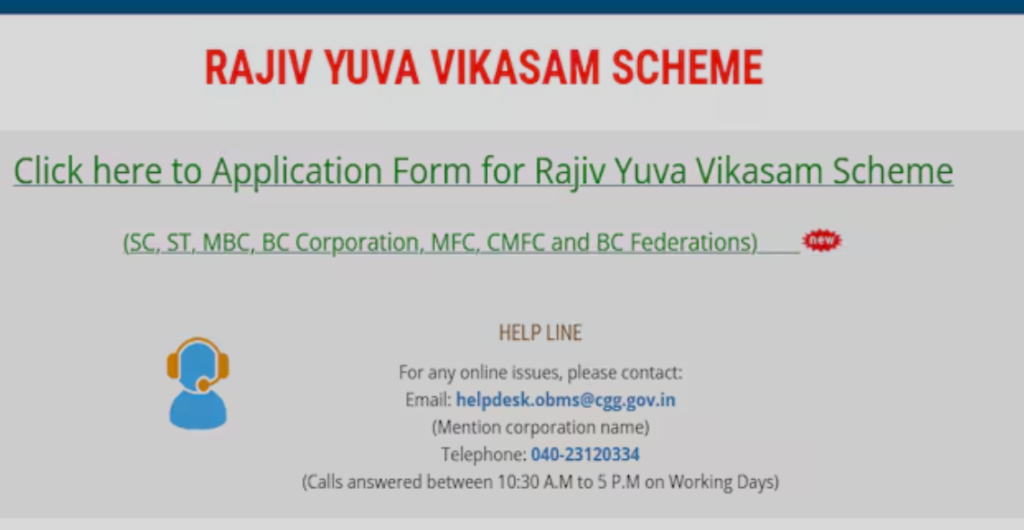The Rajiv Yuva Vikasam Scheme 2025 is Telangana’s ambitious self‑employment initiative designed to empower unemployed youth from SC, ST, BC, Minority, and EBC/EWS communities. It offers subsidised loans up to ₹3–4 lakh, along with training and handholding support to set up micro-enterprises or self-employment ventures the times of india
The scheme carried an initial budget of ₹6,000 crore, later expanded to ₹9,000 crore to meet demand Sakshi EducationThe Times of India.

Chief Minister A. Revanth Reddy
On April 11, 2025, Reddy formally launched the Rajiv Yuva Vikasam scheme, allocating an initial ₹6,000 crore to generate self‑employment opportunities for 5 lakh youth, especially from SC, ST, BC, and minority categories. The scheme promised financial support from ₹50,000 to ₹4 lakh per beneficiary YouTube+15Etemaad Daily+15YouTube+15TaxTMI+2The Times of India+2.
He emphasized that this was not a “Congress scheme” but a “people’s scheme,” intended to transform Telangana into a trillion‑dollar economy. He acknowledged fiscal challenges inherited from the previous administration and committed to maintaining fiscal discipline while expanding welfare and development initiatives The Times of India.
In a cabinet review on June 2, Reddy directed that no beneficiary list be finalized until all applications are thoroughly screened to prevent ineligible allocations The Siasat Daily+2The Times of India+2.
On June 25, in Telugu media, Reddy reaffirmed that the Congress government was fulfilling its election promises—like the Indiramma houses and free electricity—and said the Rajiv Yuva Vikasam scheme would be launched soon, focusing on empowering youth across the state
Akbaruddin Owaisi (AIMIM Floor Leader)
- At the formal launch event held in the Telangana Assembly premises, Akbaruddin Owaisi addressed the gathering and was seen applauding the CM’s announcement of the scheme Instagram+8YouTube+8Instagram+8.
- In Legislative Assembly discussions, he criticized the identification process of beneficiaries for Rajiv Yuva Vikasam, the SC/ST/EBC/minority welfare schemes, alleging irregularities. He questioned how genuinely poorer individuals could benefit when eligibility relied on ration cards and accused the government of high-income groups enjoying the scheme’s benefits. He emphasized that promised benefits were not reaching the intended marginalized groups
Timeline & Application Stats Rajiv Yuva Vikasam Scheme
- Registration & Application Window: March 15/17 – April 14, 2025 Medchal Malkajgiri District+2Sakshi Education+2
- Application Scrutiny: April 6 – May 31, 2025
- Sanction Letter Distribution (Planned): June 2–9 (Telangana Formation Day)
- Training Planned: June 10–15, followed by launching supported units instagram.com+1Moneycontrol+7ap7am.com+7Telangana Today+7newindianexpress.com+1
The scheme received an overwhelming response, with 16.23 lakh applications filed across Telangana. Breakdown shows majority—about 75%—applied for the highest category ₹2–4 lakh
Who Is Eligible for Rajiv Yuva Vikasam Scheme ?
Eligibility includes:
- Residency: Permanent Telangana domicile
- Communities: SC / ST / BC / Minority / EBC / EWS
- Age: 21–55 years for non-agriculture; 21–60 years for agri/allied sectors Moneycontrol+7EdexLive+7The Times of India+7
- Income Limits: Rural ₹1.5 lakh/year; Urban ₹2 lakh/year EdexLive+1
- Only one beneficiary per household every 5 years
- Priority reservations for first-time applicants, women (25%), PwDs (5%), martyrs’ families, skilled youth
Funding & Subsidy Structure
Loan and subsidy tiers as reported:
- Loans up to ₹1 lakh: 80% subsidy (20% borrower’s contribution or linked bank loan)
- ₹1–2 lakh: 70% subsidy
- ₹2–3 lakh: ~60% subsidy
- Some reports mention support up to ₹4 lakh for select sectors Moneycontrol+1
Mandal-level committees and welfare corporations oversee beneficiary selection
Current Status & Delays Rajiv Yuva Vikasam Scheme
The rollout has been put on hold due to severe fiscal stress. The state recorded a deficit of ₹9,000 crore per month for April–May 2025, triggered by rising expenses and delayed land sale revenues Deccan Chronicle.
Despite initial plans to issue sanction letters and commence training in early June, the government has postponed the entire exercise for a thorough review following complaints and eligibility disputes Telangana Today+1.
Officials are prioritising low‑cost units (below ₹1 lakh) first while exploring phased disbursal strategies if funds are released
Key Developments in Governance
- Scheduled Caste Sub‑categorisation was introduced to ensure fair distribution within SC communities—set to benefit around 5 lakh individuals The Times of India+1.
- Deputy CM Bhatti Vikramarka has engaged bankers and welfare officials to streamline fund linkages and rollout logistics. He had initially intended to reach five lakh beneficiaries by October 2 in the first phase Telangana Today+7
What It Means for Applicants
- If you applied between March–April 2025, your application is under extended scrutiny.
- Sanction letters and training schedules are paused for now; awaiting cabinet review.
- Plans may shift to phased rollout—launching small units first and expanding as funds permit.
- Check application status on the OBMMS portal; reach out locally at Mandal/District help desks.
- Stay updated via official district websites or Gazette announcements for fresh timelines.
Summary at a Glance
| Aspect | Status / Detail |
|---|---|
| Applications Received | ~16.23 lakh youth |
| Budget Allocated | Initially ₹6,000 Cr; increased to ₹9,000 Cr |
| Eligibility | SC/ST/BC/Minority/EBC; income & age limits apply |
| Proposed Benefits | Loans up to ₹3‑4 lakh with 60–80% subsidies |
| Scheme Rollout | Held up since June due to fiscal constraints |
| Phased Approach | Planned starting ₹50 K–₹1 L slabs first |
| SC Sub‑Category Rollout | Active under scheme; ~5 lakh to benefit |
Despite the current implementation pause, the Rajiv Yuva Vikasam Scheme remains one of Telangana’s significant welfare initiatives aimed at facilitating youth entrepreneurship. Once finances are stabilised and policies fine-tuned, it’s expected to restart with modified timelines and structured rollout plans.
sources